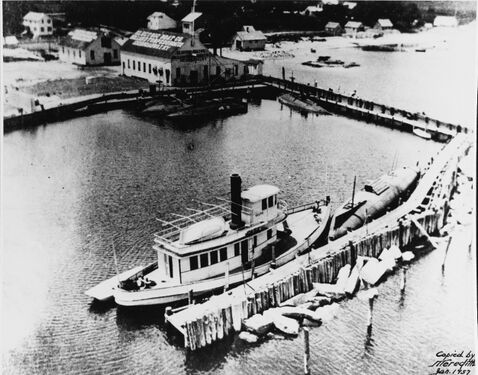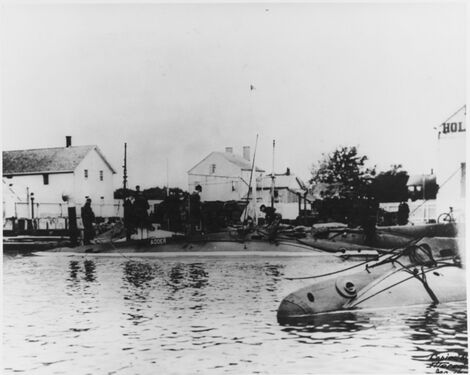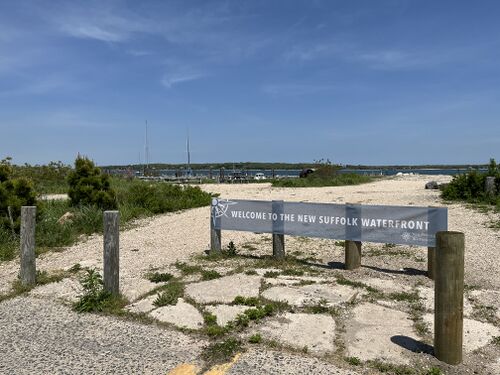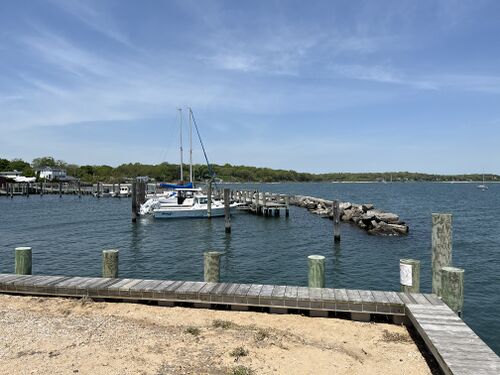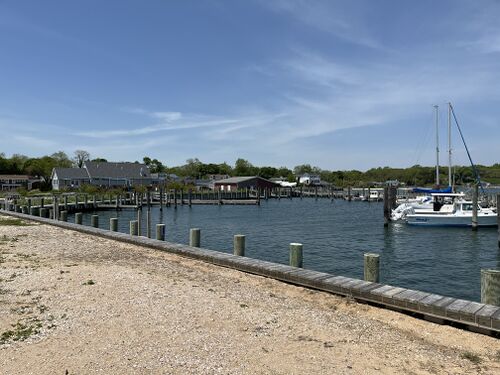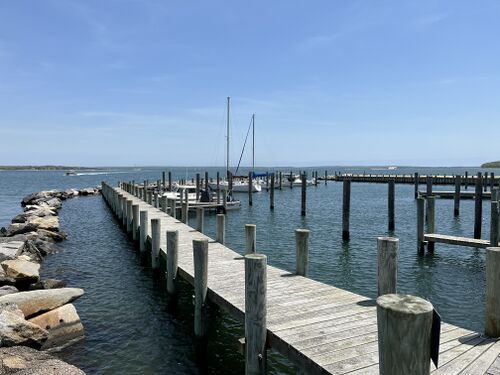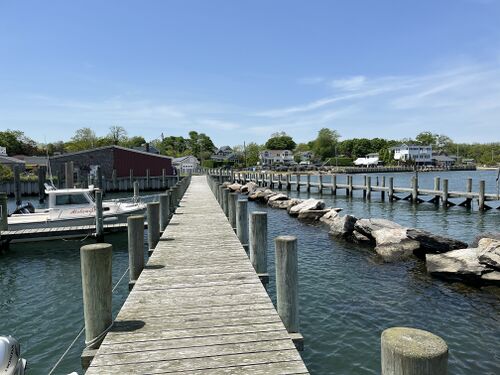Holland Torpedo Boat Company Station: Difference between revisions
Pbcjohnston (talk | contribs) mNo edit summary |
Pbcjohnston (talk | contribs) mNo edit summary |
||
| (16 intermediate revisions by the same user not shown) | |||
| Line 1: | Line 1: | ||
[[File: | {{#seo:|title=The Holland Torpedo Boat Company station in New Suffolk, NY - PigBoats.COM|keywords=Holland submarine base, New Suffolk NY, submarine heritage, submarine base, Long Island history}} | ||
{{#metamaster:description|The story of the Holland Torpedo Boat Co. base at New Suffolk, NY.}} | |||
[[File:New Header 1 A-class.jpg]] | |||
=== <big>The Holland Torpedo Boat Company Station</big> === | === <big>The Holland Torpedo Boat Company Station</big> === | ||
<div style="text-align: justify;"><span style="color:#00008B">In late 1898 American inventor and submarine pioneer John P. Holland was exhausted from the nearly unrelenting activity needed to get his submarine, the Holland VI, ready for U.S. Navy trials. Needing an influx of capital to continue to fund the tests and realizing that a full production capability was needed to build follow-on units should the Holland VI be accepted, Holland agreed to have his Holland Torpedo Boat Company acquired by the newly formed Electric Boat Company. EB was the brainchild of Isaac Rice, a New York City capitalist who was eager to explore the potential of submarines in naval operations. HTBC was to be a wholly owned subsidiary of EB with John Holland as its general manager and financier Elihu B. Frost as Secretary-Treasurer. | <div style="text-align: justify;"><span style="color:#00008B">In late 1898 American inventor and submarine pioneer John P. Holland was exhausted from the nearly unrelenting activity needed to get his submarine, the Holland VI, ready for U.S. Navy trials. Needing an influx of capital to continue to fund the tests and realizing that a full production capability was needed to build follow-on units should the Holland VI be accepted, Holland agreed to have his Holland Torpedo Boat Company acquired by the newly formed Electric Boat Company. EB was the brainchild of Isaac Rice, a New York City capitalist who was eager to explore the potential of submarines in naval operations. HTBC was to be a wholly owned subsidiary of EB with John Holland as its general manager and financier Elihu B. Frost as Secretary-Treasurer. The corporate offices were at 100 Broadway in New York City.<br><br> | ||
[[File:Holland under tow for Gport trials.jpg|275px|thumb|left|<small>Holland VI under tow to the New Suffolk station, summer 1899</small>]]Holland, never the savvy business man, was further exhausted by all the machinations of the business world and decided that he needed a break to rejuvenate his energies. He set off for his native homeland Ireland, looking for a good rest. Nearly as soon as Holland's passenger ship cleared New York Harbor, Rice set in motion a plan to move the Holland VI and most of the HTBC subsidiary to a new facility off Cutchogue Harbor and Little Peconic Bay, Long Island at a little town called New Suffolk. Rice leased the Goldsmith & Tuthill Boat Yard along First Street in New Suffolk and set up a dedicated maintenance and storage facility, along with a machine shop and a draftsman's shop. The yard had a hook shaped stone rip-rap breakwater that formed a small protected basin that would provide docking space for the Holland VI and any potential follow-on sister craft. Accommodations were acquired in the town for the company's personnel, including Holland and Frost. The new facility was not a construction yard, as it lacked the space for building ways. The Holland VI's construction had been sub-contracted to Lewis Nixon's Crescent Shipyard at Elizabeth, NJ, and it was likely that follow-on boats would be built there as well. The New Suffolk station was for final fitting out, repairs, and testing only.<br><br> | |||
[[File:Holland Station New Suffolk 4.jpg|275px|thumb|right|<small>HTBC employees in front of the machine shop, circa 1900. Note how the rooftop sign was worded here. Compare to the later picture below.</small>]] The move of the HTBC subsidiary to New Suffolk without Holland's knowledge was actually one of a series of Machiavellian business moves by Rice, who sought total control of the company and was seeking to move Holland out of the way, literally and figuratively. Holland had already signed over his patents to Electric Boat in a move to raise capital for continued tests and future construction. However, there was also a very practical reason for the move as well. The previous testing areas for the Holland boat had been in Raritan Bay off Staten Island, NY and Perth Amboy, NJ near the Crescent building yard. Inevitably, the trials of the submarine garnered tremendous interest from the press and the New York City public alike and the submarine was often accompanied by a plethora of pleasure craft, making it potentially dangerous to operate the boat submerged. The move to rural New Suffolk gave the company a reasonably private operating area to test the boat in, and it kept it from the bulk of the prying eyes of the press. | |||
[[Holland|'''The trials of the Holland VI on Great Peconic Bay were entirely successful''']] and after a haulout for minor modifications and repairs at Greenport, NY and one more trial run the boat was finally purchased by the Navy in April, 1900 and commissioned as the Holland on October 12, 1900. Electric Boat, however, was already looking to the future. Entirely at their own expense they contracted with Crescent Shipyard to build a larger and improved version of the Holland, with the intent of using her as a demonstration model for seven copies that Rice was working diligently to get the Navy to purchase. This new boat, called Fulton, was quickly moved to New Suffolk for testing and demonstration trials. The Fulton trials were entirely successful and they cleared the bureaucratic log jam around the authorization for the seven [[A-class|'''Adder-class''']] submarines, five of which quickly followed the Fulton to New Suffolk (the other two were built in San Francisco). | |||
<gallery mode="packed" widths="350px" heights="250px"> | |||
File:Holland Station New Suffolk 2 NH 42623.jpg|<small>The EB/HTBC facility at New Suffolk. The tug Kelpie is in the foreground, with the hulk of the 1895 Plunger moored ahead of it. In the background are several of the Adder-class submarines. Note the sign on the roof of the machine shop/draftsman's shop.</small> | |||
File:Holland Station New Suffolk 1 NH 45937.jpg|<small>Several of the Adder-class boats moored at the northern corner of the basin. [[A-4|'''Moccasin (Submarine No. 5)''']] is in the right background.</small> | |||
File:Holland Station New Suffolk 3 NH 57728.jpg|<small>A view looking back from about half-way down the quay wall. [[A-2|'''Adder (Submarine No. 3)''']] is in the background.</small> | |||
</gallery> | |||
</center> | |||
Fulton, Adder, Plunger, Moccasin, Porpoise, and Shark were joined in New Suffolk by a company owned tugboat called the Kelpie, which accompanied the boats as they made their initial trial runs in Great Peconic Bay. In addition, the hulk of a never completed steam powered submarine contracted to Holland's company in 1895 (also called the Plunger) was towed up to the station and moored to the quay wall inside the basin. Sleepy little New Suffolk became a busy and prosperous place for several years, with the new Adder-class submarines arriving regularly and trials being run out in the bay. New Suffolk was far enough away from New York City to keep the public and press at bay, but Rice was savvy enough to understand the advantages of getting favorable publicity and thus selected members of the press were often invited out to view the comings and goings around the station. The nearby southern shore of Long Island was also becoming a popular destination for summer vacations of the New York elite, and thus viewing the submarine movements became a favored pastime for Rice's urban colleagues. In addition, many high ranking Naval officers visited the site to see how the boats performed. Of course, the town played host to the incoming crews of the new submarines. | |||
[[File:Holland Station New Suffolk 5.jpg|275px|thumb|left|<small>Another view from the middle of the quay wall. The new [[A-1|'''Plunger (Submarine No. 2)''']] is alongside another boat on the right. The Fulton is just visible on the left. She was not purchased by the USN and was eventually sold to Russia under clandestine circumstances.</small>]] The heyday of New Suffolk as a center of submarine activity was short. The last of the Adder-class boats, [[A-7|'''Shark (Submarine No. 8)''']] was commissioned on September 19, 1903 and New Suffolk quickly grew quiet. Submarine technology was rapidly advancing and Electric Boat was moving on to the much larger and more capable [[B-1|'''Viper (Submarine No. 10)''']] and [[C-1|'''Octopus (Submarine No. 9)''']] classes and these boats were too big to be adequately moored in the small New Suffolk basin, whose water depth was also not sufficient for the bigger boats. In addition, Rice continued his business maneuvering and had been slowly but surely forcing Holland out of the company that he had founded. Holland, even though a brilliant engineer, had always been an irascible and stubborn man and had frequently been at loggerheads over technical matters with Rice, company engineer and trials captain Frank Cable, the new chief engineer Lawrence Y. Spear, and eventually even his friend Elihu Frost. The others saw Holland's engineering philosophy as being too limited, and his stubborn refusal to accept changes to his designs, ''even when the changes were shown to be beneficial and advantageous,'' made him an exasperating man to work with. Holland's contract with EB came to an end on March 31, 1904 and he resigned from the company. Rice, Spear, and Cable were eager to see him go and they figuratively held the door open for him. Seeking to divest the company from any remaining Holland legacy, Rice and Spear contracted with Fore River Shipbuilding in Quincy, MA for the Viper and Octopus-class boats, cutting out Holland's preferred Crescent. The New Suffolk facility was closed in 1905 with facilities reverting to their former owner Goldsmith & Tuthill. | |||
<br> | |||
<center>[[File:RWB_starbar.jpg]]</center> | |||
The site stayed in the Tuthill family and continued to operate as a boatyard and eventually a fuel oil distribution site. The family sold off the oil business in 1976. Mr. J. Arthur Kenniff purchased the boatyard portion in 1960 and built and repaired boats there until at least 1983. Eventually the site came under the ownership of the local Cutchogue/New Suffolk government. There was a plan at one point of developing the site with condominiums, but that never came to pass due to opposition by local residents. Today, the site is called "The New Suffolk Waterfront", with the old Holland basin the mooring site of several small yachts and boats. | |||
Holland, | New Suffolk has reverted to its pre-Holland 1899 ideal. The town is charming and quaint, with modest but stately homes gracing the hilly streets. Life seems to run at a slower pace there, and the approximately 500 residents seem to like it that way. As far as can be determined, no buildings from either the Goldsmith & Tuthill days or the HTBC residency remain. However, there is one building at the northern corner of the basin that sits on the site of the old machine shop building. | ||
<gallery mode="packed" widths="350px" heights="250px"> | |||
File:New Suffolk 2024 waterfront.JPG|<small>A cheerful sign belies the quaint nature of the old Holland basin. Photo by Dave Johnston, May 2024.</small> | |||
File:New Suffolk 2024 basin 1.JPG|<small>The end of the rip-rap quay wall. This is where the Kelpie and the 1895 Plunger were moored in the first gallery photo above. Photo by Dave Johnston, May 2024.</small> | |||
File:New Suffolk 2024 basin 2.JPG|<small>Looking back over the basin to the northwest. Photo by Dave Johnston, May 2024.</small> | |||
File:New Suffolk 2024 basin 3.JPG|<small>View from the north corner of the basin, looking down the "hook" of the quay wall. Photo by Dave Johnston, May 2024.</small> | |||
File:New Suffolk 2024 basin 4.JPG|<small>Looking to the north corner of the basin. This view corresponds to the middle photo in the gallery above. Photo by Dave Johnston, May 2024.</small> | |||
File:New Suffolk 2024 basin 5.JPG|<small>Looking back up the long dock to the north corner. The building in the background sits on the site of the old Holland machine shop, the one with the sign on the roof. Photo by Dave Johnston, May 2024.</small> | |||
</gallery> | |||
</center> | |||
[[File:New Suffolk 2024 basin 6.JPG|275px|thumb|right|<small>The author in May 2024 at the New Suffolk site. Directly behind him would have been the mooring spot for the tug Kelpie and the old 1895 Plunger.</small>]] The author visited the site in May 2024 and took all of the color pictures. It is quiet and peaceful and a few moments of reflection at a nearby picnic table gave me the opportunity to imagine the former hustle and bustle of the place during the Holland days. I could almost hear the conversations of the Holland workmen as they sat and ate their lunch overlooking the picturesque Cutchogue Harbor and Great Peconic Bay. The presence of the great John P. Holland was strong, and I was struck by a mental image of him pacing the waterfront near my bench, perhaps arguing in his strong Irish brogue with the capable Frank Cable. It was a humbling experience that thrilled the soul of this historian. | |||
The people who currently live in the area keep the memory of the submarine activities alive by keeping up the site and providing picnic tables. They are ably assisted by submarine veterans of the local chapter of [https://www.ussvi.org/ '''USSVI.'''] There is a flag pole that proudly flies the national ensign, and a memorial plaque that lets visitors know the significance of the area has been installed near the parking lot. Their enthusiasm for their past is evident in the plaque, but in reality the location could not be actually called a "base" in the traditional sense of the word. It was always a privately owned facility, with no official Navy presence here other than the inbound crews and the occasional high ranking officer. Even still, it is a fitting tribute to a small but significant part of the history and heritage of the United States Submarine Service. I would like to express my thanks to the people of Cutchoque/New Suffolk and to my brothers in USSVI for their efforts in preserving the site for our posterity.<br><br> | |||
[[File:New Suffolk 2024 waterfront 2.JPG|thumb|center|<small>Photo by Dave Johnston, May 2024.</small>]] | |||
[[File:Red bar sub new.jpg]] | [[File:Red bar sub new.jpg]] | ||
| Line 15: | Line 50: | ||
Page created by:<br> | Page created by:<br> | ||
<span style="color:#00008B"> | <span style="color:#00008B"> | ||
<small> | <small>David Johnston<br> | ||
2024 - PigBoats.COM<sup>©</sup><br> | |||
Norfolk, VA<br> | |||
[mailto:webmaster@pigboats.com '''webmaster@pigboats.com''']</small> | [mailto:webmaster@pigboats.com '''webmaster@pigboats.com''']</small> | ||
</center> | </center> | ||
[[File:Subs bottom line 2.jpg]] | [[File:Subs bottom line 2.jpg]] | ||
Latest revision as of 13:13, 11 April 2025
The Holland Torpedo Boat Company Station
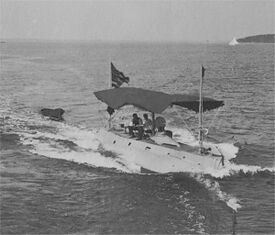
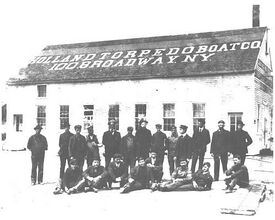
The trials of the Holland VI on Great Peconic Bay were entirely successful and after a haulout for minor modifications and repairs at Greenport, NY and one more trial run the boat was finally purchased by the Navy in April, 1900 and commissioned as the Holland on October 12, 1900. Electric Boat, however, was already looking to the future. Entirely at their own expense they contracted with Crescent Shipyard to build a larger and improved version of the Holland, with the intent of using her as a demonstration model for seven copies that Rice was working diligently to get the Navy to purchase. This new boat, called Fulton, was quickly moved to New Suffolk for testing and demonstration trials. The Fulton trials were entirely successful and they cleared the bureaucratic log jam around the authorization for the seven Adder-class submarines, five of which quickly followed the Fulton to New Suffolk (the other two were built in San Francisco).
-
The EB/HTBC facility at New Suffolk. The tug Kelpie is in the foreground, with the hulk of the 1895 Plunger moored ahead of it. In the background are several of the Adder-class submarines. Note the sign on the roof of the machine shop/draftsman's shop.
-
Several of the Adder-class boats moored at the northern corner of the basin. Moccasin (Submarine No. 5) is in the right background.
-
A view looking back from about half-way down the quay wall. Adder (Submarine No. 3) is in the background.
Fulton, Adder, Plunger, Moccasin, Porpoise, and Shark were joined in New Suffolk by a company owned tugboat called the Kelpie, which accompanied the boats as they made their initial trial runs in Great Peconic Bay. In addition, the hulk of a never completed steam powered submarine contracted to Holland's company in 1895 (also called the Plunger) was towed up to the station and moored to the quay wall inside the basin. Sleepy little New Suffolk became a busy and prosperous place for several years, with the new Adder-class submarines arriving regularly and trials being run out in the bay. New Suffolk was far enough away from New York City to keep the public and press at bay, but Rice was savvy enough to understand the advantages of getting favorable publicity and thus selected members of the press were often invited out to view the comings and goings around the station. The nearby southern shore of Long Island was also becoming a popular destination for summer vacations of the New York elite, and thus viewing the submarine movements became a favored pastime for Rice's urban colleagues. In addition, many high ranking Naval officers visited the site to see how the boats performed. Of course, the town played host to the incoming crews of the new submarines.
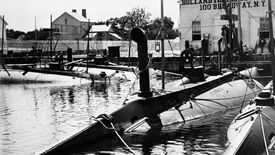
The site stayed in the Tuthill family and continued to operate as a boatyard and eventually a fuel oil distribution site. The family sold off the oil business in 1976. Mr. J. Arthur Kenniff purchased the boatyard portion in 1960 and built and repaired boats there until at least 1983. Eventually the site came under the ownership of the local Cutchogue/New Suffolk government. There was a plan at one point of developing the site with condominiums, but that never came to pass due to opposition by local residents. Today, the site is called "The New Suffolk Waterfront", with the old Holland basin the mooring site of several small yachts and boats.
New Suffolk has reverted to its pre-Holland 1899 ideal. The town is charming and quaint, with modest but stately homes gracing the hilly streets. Life seems to run at a slower pace there, and the approximately 500 residents seem to like it that way. As far as can be determined, no buildings from either the Goldsmith & Tuthill days or the HTBC residency remain. However, there is one building at the northern corner of the basin that sits on the site of the old machine shop building.
-
A cheerful sign belies the quaint nature of the old Holland basin. Photo by Dave Johnston, May 2024.
-
The end of the rip-rap quay wall. This is where the Kelpie and the 1895 Plunger were moored in the first gallery photo above. Photo by Dave Johnston, May 2024.
-
Looking back over the basin to the northwest. Photo by Dave Johnston, May 2024.
-
View from the north corner of the basin, looking down the "hook" of the quay wall. Photo by Dave Johnston, May 2024.
-
Looking to the north corner of the basin. This view corresponds to the middle photo in the gallery above. Photo by Dave Johnston, May 2024.
-
Looking back up the long dock to the north corner. The building in the background sits on the site of the old Holland machine shop, the one with the sign on the roof. Photo by Dave Johnston, May 2024.
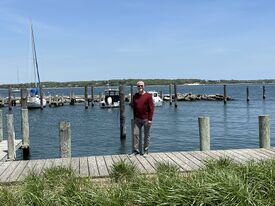
The people who currently live in the area keep the memory of the submarine activities alive by keeping up the site and providing picnic tables. They are ably assisted by submarine veterans of the local chapter of USSVI. There is a flag pole that proudly flies the national ensign, and a memorial plaque that lets visitors know the significance of the area has been installed near the parking lot. Their enthusiasm for their past is evident in the plaque, but in reality the location could not be actually called a "base" in the traditional sense of the word. It was always a privately owned facility, with no official Navy presence here other than the inbound crews and the occasional high ranking officer. Even still, it is a fitting tribute to a small but significant part of the history and heritage of the United States Submarine Service. I would like to express my thanks to the people of Cutchoque/New Suffolk and to my brothers in USSVI for their efforts in preserving the site for our posterity.
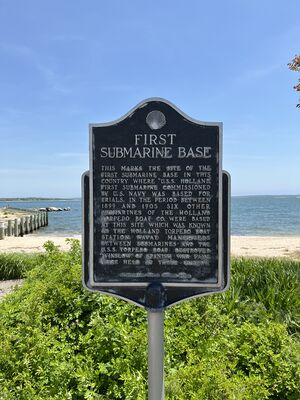
Page created by:
David Johnston
2024 - PigBoats.COM©
Norfolk, VA
webmaster@pigboats.com

